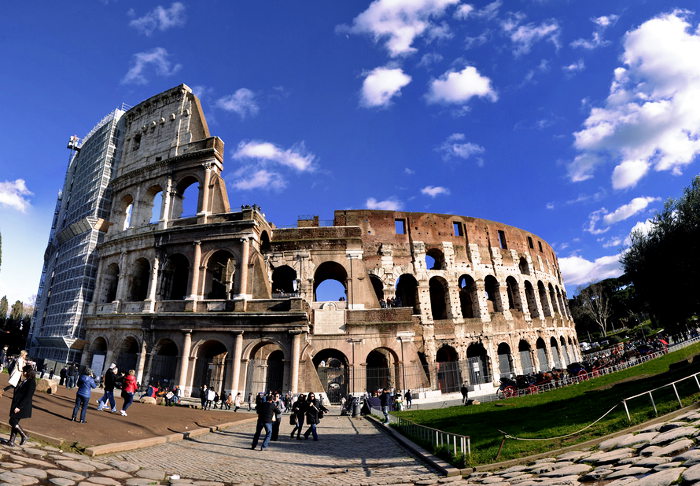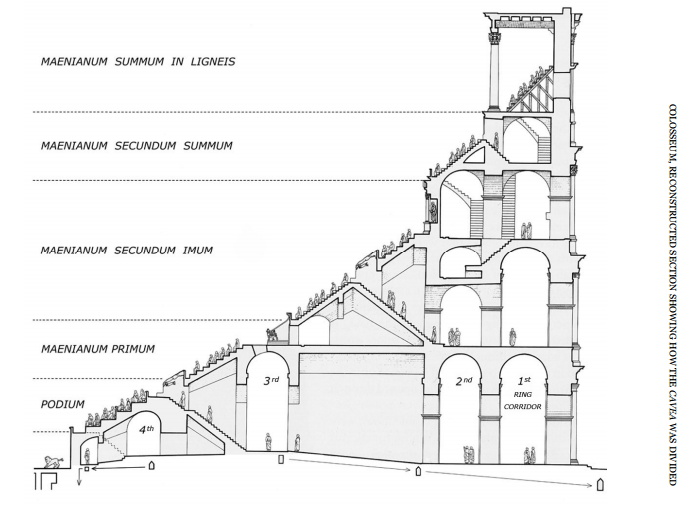
If you want to go deep into the knowledge of the Roman Colosseum, here are some information about its architecture. I am going to introduce you to the structure of the Colosseum, the arena, the seats and the cellars. The structure of the amphitheatre is made of blocks of travertine (external walls and load-bearing pillars), bricks and blocks of tufa (radial walls and stairs). The exterior of the building is divided into four levels that add up to a total height of about 50 meters. The last level was crowned with a marble colonnade, whose fragments are still visible on the ground floor. Just walking around the Colosseum, you can see that the building has an elliptical shape with a long axis of 188 metres and a short one of 156 metres.

Now, we get inside. In the centre of the building there was the arena, a wooden floor (now partly reconstructed on the eastern side) on which the games took place and that was covered with sand (arena in Latin). If you visit the Colosseum, the arena is not sandy, but you will see what was underneath. The amphitheatre had 80 archways: 76 entrances were numbered and intended for the spectators while four ones, located on the ends of the ellipse’s axes, were reserved for the emperor, for the political and religious authorities and for the protagonists of the spectacles. The monumental entrances on the short axis led to two royal boxes near the arena, one of which reserved for the emperor. On the occasion of the spectacles the public took a seat according to a rigid division based on social classes: a ticket indicated the seat assigned and obligatory pathways led to the tiers of seats (cavea) through numbered archways.
The cavea, that could contain between 40.000 and 70.000 spectators, was divided into 5 horizontal sectors (maeniana), separated by corridors. The senators occupied the section of seats closest to the arena (podium). The upper stands were reserved to the knights and to other social categories, whereas the highest columned sector (summa cavea) was designed for the plebs and furnished with wooden structures. Like many of our modern sports arena, also the Colosseum had a kind of parasol: on the top there was a mobile structure in wood and cloth (velum) to shelter the public from the sun.

Originally, the building structures today visible in the middle of the monument were cellars, covered throughout with the floor of the arena, like I have said before in this post. They were built mostly some years after the amphitheatre’s inauguration, under Domitian’s empire (AD 81-96) and were restored several times during the five centuries of the Colosseum’s activity. The cellars were organized into 15 corridors, made in blocks of tufa and bricks, parallel to a central gallery running east-west along the long axis of the ellipse. The cellars housed the equipment needed for the games, the weapons and the cages of the animals. A system of goods-hoists moved by winches was used to lift gladiators, animals and stage machineries just below the level of the arena, which was reached through trap-doors and inclined planes. The goods-lifts set along the side corridors, the largest ones, were equipped with cages for hoisting the animals; instead, those located in the middle cellars were used for people and scenographies. The housings of these machineries and of the load-bearing poles of the arena are still visible on the cellars’ floor. The central corridor under the arena continued underneath the eastern entrance, connecting the cellars with the most important barracks of the gladiators, the Ludus Magnus, today partially visible in the archaeological area between Via Labicana and Via di San Giovanni in Laterano. Another underground corridor, known as Passageway of Commodus (the emperor who, according to historical sources, underwent an attempted assassination there), connected the cellars with the outside; the gate leading from this passageway to the cavea is still visible today near the terrace on the southern side.
Follow me, I am going to write a lot about Rome! The historical information in this post are taken by the Soprintendenza Speciale per i Beni Archeologi di Roma. The first pictures is by Luca Serazzi, the second one is by Jvieras.


Leave A Comment